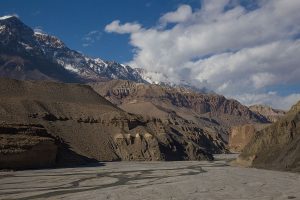Guest Author: James Ormiston
Palaeontology MSci Graduate / Palaeoartist
Ammonites are wonderful things. Staring into their ribbed spirals can be a hypnotic experience. A shape that is vaguely familiar…yet also alien and ancient. Geometrically satisfying, chronologically dizzying. Although being very common, it’s this slight “otherness” which all but guarantees that if you collect fossils, even only a little, you probably have an ammonite in your collection. They have become a poster child for fossils worldwide.
There are many historical records of people finding ammonites, baffled by their uncanny organic form rendered in lifeless stone. Often their existence was explained with myth and religion since the science of palaeontology didn’t begin in earnest until around the 18th century. In 79 AD the origin of the word “ammonite” came from Pliny the Elder, who named them after the Egyptian god Ammon due to their resemblance to ram’s horns, which Ammon sometimes sported.
Another such religious interpretation can be found close to Bristol. Saint Keyne was said to have once lived near the River Avon, which became infested with snakes. She turned the snakes to stone, and the ammonite fossils still found at Keynsham today were served as proof of it. These so-called “snake-stones” were also found at the famous gothic haven of Whitby, Yorkshire, where Saint Hilda performed the same feat. So well-told was the snake story that throughout the years snake heads were carved into ammonites.

Gods & Cephalopods
Wherever ammonites were found, different stories and uses sprang up around them. One particularly interesting example can be found in the Himalayas of Nepal. As far as landscapes go, it doesn’t get much further from Whitby than the world’s deepest river gorge, where ammonites are rolled through the shadows of some of its highest mountains. The ammonites here are Jet-black (though not made of Jet; Jet comes from plant material) and their surrounding nodules rounded by the Gandaki River, a tributary of the Ganges.
In a number of Hindu scriptures dating back many centuries, there is mention of stones called shaligram. Shaligram are said to be from the body of the god Vishnu, who in one of his incarnations was cursed to turn to stone on the banks of the Gandaki (the Gandaki being formed from the goddess Tulsi, who placed the curse on him and was cursed herself).


Fossil bivalves and belemnites are also found in the river, and since they are preserved in the same rock as the ammonites, they too are considered shaligram stones and thus sought-after sacred objects. The stones are not used as idols per se, which are brought into a house as a vehicle for gods to enter and be worshipped through, but as physical, non-human manifestations of Vishnu himself. They don’t just represent; they are. So valued are these stones that people make lengthy pilgrimages to the remote Gandaki and the nearby hillside temple, Muktinath, to see and acquire them.
And just as every fossil tells a story of its past, so shaligram stones are studied by practitioners who search their surfaces and cross-reference their features with Hindu symbology to assign each stone its own identity. A palaeontologist sees suture lines and siphuncles; the practitioners see wheels, flowers and other symbols of the scriptures.


Unlike the snakestones of Keynsham and Whitby, this is an attached belief system which has continued and grown in momentum. Also unlike the snakestone carvings of yore, today it is not simply people assigning religious explanations to fossils because they don’t know what they are. While on expedition in the region, ethnographer Dr Holly Waters (of Wellesley College, Massachusetts, USA – a leading voice in western research of shaligram traditions) was told by a local that it is widely recognised…
“This is what science tells us. You think that we reject this, but we do not. Science is right, you see…Vishnu comes in the form that is needed most, so this one comes in the form of science. He is God moving as fossil, hiding in fossil…”
…the belief in them being manifestations of a god is, at least sometimes, additional to the understanding of them being the remains of ancient sea creatures, not instead of it.
The stones are also unfortunately the subject of questionable practices for commercial gain. Their religious significance has been cross-pollinated into westernised esoterica like crystal healing which has driven up demand, fuelled the spread of fakes, and sparked concerns over appropriation. After all, shaligram practice dictates that the stones are not allowed to have a monetary value attached to them.
Ghosts of the Neotethys
So, this being a palaeontology blog, what is known about the natural origin of the shaligram stones? As mentioned, the stone containing the fossils is black. Specifically, it is a black shale. Black shale is formed in extremely low-oxygen conditions underwater, referred to as anoxia, resulting in a high concentration of organic carbon which produces the black colour. Black shales are what many petroleum and gas reserves come from.
This black shale lies among a wider group of rocks called the Spiti Shales, which can be found exposed in a number of places across the Himalayas, deposited from the Middle Jurassic to the Early Cretaceous (~166 – 140 million years ago). During this time the land mass forming much of the modern Indian subcontinent, the Indian Plate, was in a very different place to today. It sat south of the equator, neighbouring what would eventually become Antarctica and Australia, together part of a larger continent called Gondwana. After the break-up of Gondwana during the Cretaceous, the Indian Plate moved north across an ancient sea called the Neotethys. It moved very quickly (geologically speaking!) and smashed into Asia about 50 million years ago, beginning the formation of the Himalayas.

When the ammonites in the shaligram stones were alive, floating around in the sea, they were at the southern edge of the Neotethys. Dr Waters notes that shaligram ammonites usually belong to one of four genera: Blandifordiceras, Haplophylloceras, Aulacosphinctus and Aulacosphinctoides. Stratigraphic surveys indicate they were situated in a region called the outer shelf, meaning that they were in relatively shallow seawater, but also not far from where the continental plate drops down into the deep ocean. Their fossils were uplifted to altitudes thousands of metres above sea level when the Himalayas formed from the buckling of the Indian Plate during its collision with Asia (like crumpling up a drinks can) and today they are being eroded out. Scriptures as far back as the 12th Century even identify two distinct types of shaligram – the smooth ones found in the river and the rough ones found on the hillsides, freshly eroded but un-rounded by water action.
Non-Overlapping Magisteria
The famous evolutionary biologist and science writer, Stephen Jay Gould, promoted the argument that science and religion deal with different aspects of life and should therefore not deal with each other’s businesses too much. Science shouldn’t always be actively trying to disprove religion, and religion shouldn’t deny observations made by science. The measurable vs the meaning. Considerable debate has been had over this concept, and in the case of the shaligram stones we find ourselves in a bit of a grey area…because they occupy both sides of the coin, with the sides apparently not being entirely at odds in the minds of their followers.
Let’s say you’re in Oxford, and happen across a Nepalese black ammonite in a shop of curios. You buy it, and after some research you realise its significance both as a fossil and a shaligram. Would you donate it to a museum? If so, which one? The Oxford Museum of Natural History and the anthropological collections of the Pitt Rivers Museum are right next to each other, and the Ashmolean Museum of Art and Archaeology is just down the road. Is it a mineralogical specimen to be given little more than a label with its species name on it, or is it a cultural piece to be presented with the story of Vishnu’s curse and the pilgrimages built around it? Could it be both? Would you even donate it at all? Would you instead send it back to Nepal for repatriation? Or would you keep it because ammonites look cool?
References
Waters, H. “Living Fossils”
Waters, H. “Peregrination – The Ethnography of Shaligram Shila”
Fürsich, F. T. et al. (2021) Facies analysis and palaeoecology of the Jurassic Spiti Shale Formation in the Spiti area, Northern India. Journal of Palaeogeography 10, 438 – 462
James Ormiston graduated from the Palaeontology & Evolution MSci at the University of Bristol in 2016. He is now a palaeoartist (@notsimro) and lab technician.
Edited by Rhys Charles

